What Not to Miss at the Uffizi Gallery: 10 Masterpieces
Trying to choose favorites in the Uffizi Gallery is kind of like trying to choose a favorite child, but it’s something every tour guide at the Uffizi has to do each time we walk into what once was the Medici’s private collection. The gallery houses the largest collection of Renaissance paintings in the world so you simply have to pick and choose or you could spend days here tracing the origins of art from ancient Roman times to the Middle ages, Renaissance and beyond.
Uffizi Gallery Private Tour: Explore the Heart of the Renaissance
Skip the line at Florence’s Uffizi Gallery and discover the largest collection of Renaissance paintings in the world. With a private guide enlivening the gallery highlights with anecdotes and historical context, you’ll gain a more thorough and textured experience of pieces by Botticelli, Michelangelo, Leonardo, Raphael and more.
As a tour guide, I’ve been to the Uffizi more times than I can count but I still manage to find a new detail or a new perspective with every visit. This list of ten must sees are my personal top Highlights of the Uffizi Gallery. If it’s your first time visiting, you can’t miss these and even if it’s your hundredth visit, they still merit another look for their groundbreaking techniques, the great artists behind them and their sheer beauty. The Uffizi is a gallery that deserves to be slowly explored, savored, and visited repeatedly to soak up the beauty of Italian art again and again.
For a private tour of the Uffizi, click here. For a small group tour of the Uffizi, click here.
INSPIRATION
Vasari Corridor Re-Opens to the Public: All You Need to Know
Top Ten Uffizi Gallery Must Sees
It can take hours to visit the whole museum, that’s why it is important to make a selection and know exactly which masterpieces you must absolutely see.
Botticelli Rooms
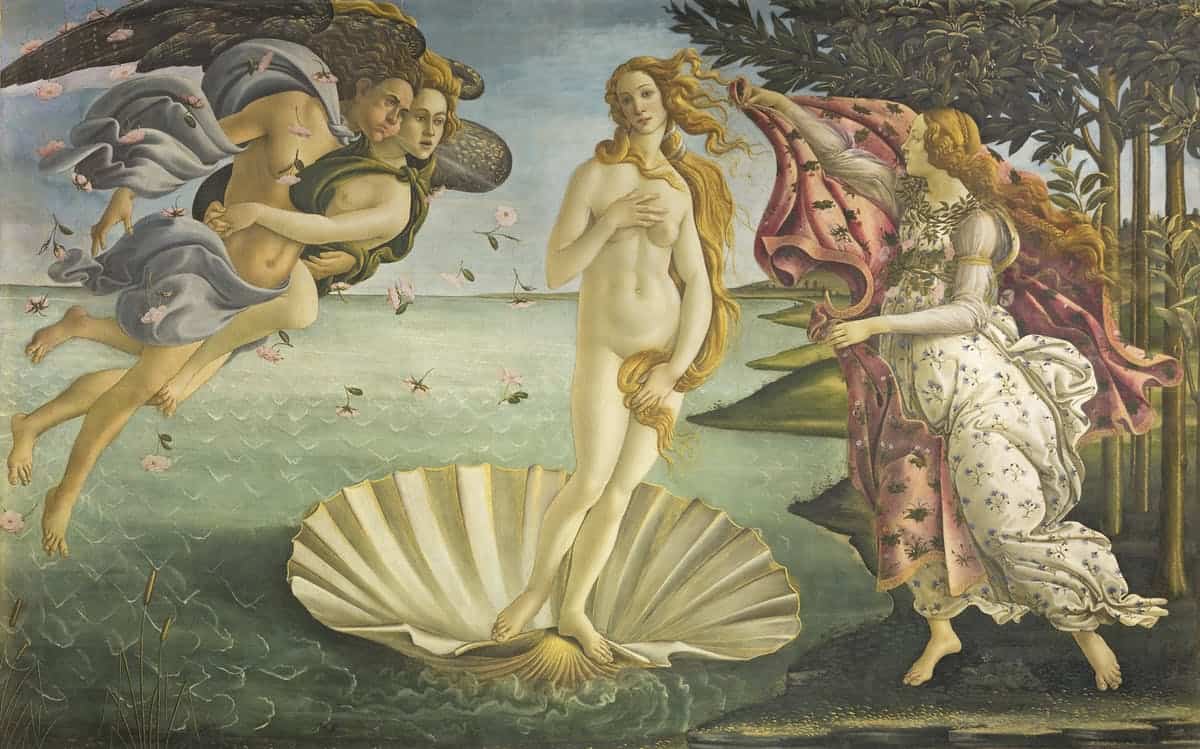
After exploring the rooms of medieval and early Renaissance art (and I wish I could dedicate another top ten list just to these) walking into the Sandro Botticelli rooms always takes my breath away. From chaste Marys and Biblical scenes of the Magi, you are met with an explosion of sensuality in a piece like The Birth of Venus (c. 1485). The goddess of love and desire, just been born from the sea and is buffeted to shore by winds Zephyr and Aura to be met by Flora on the shore. Botticelli’s work defies the trend toward perfectionism and accuracy in his figures in favor of conveying the concepts of beauty and grace. In the Primavera (c. 1480) gauzy draperies hardly conceal each feminine form and the floors of the painting is carpeted with flowers. Even in the numerous paintings with biblical themes, the dewy skin, limpid eyes and luscious mouths of Botticelli’s women call out to the viewer with their sheer beauty.
The Tribune of Francesco I de Medici
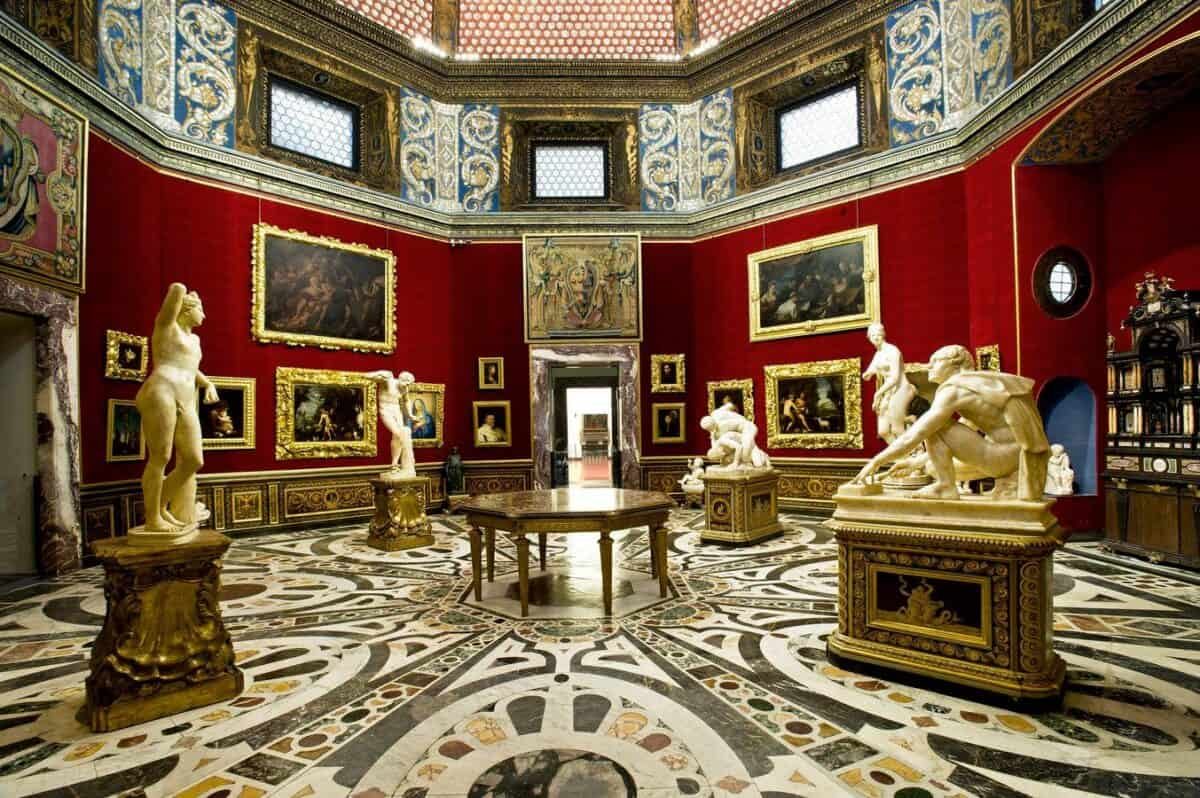
Imagine if a room could be a treasure chest and its very walls, floor and ceiling, just some of the jewels contained within. Such is the Tribune of Francesco I de Medici, an octagonal chamber that you could miss as you walk down the first hallway of the Uffizi if it weren’t for the crowds of people waiting simply to peer inside. Francesco I, like many nobles of the time, was a great collector of art and curiosities and he wanted a room that would serve as a container for his collection. From 1581-1582 Bernardo Buontalenti constructed the Tribune to be a miniature representation of the four earthly elements, a sort of container of the wonders of the cosmos. Thus the floor is a flower of inlaid marbles to represent earth. The lush, red velvet walls are fire. The ceiling, embedded with 5,780 mother of pearl shells from the Indian Ocean is water. And a lantern at the top, serving as a weather vane and sundial, the air. As Duke of Florence, in a room like this Francesco must have felt himself to be master of the cosmos.
View of the Ponte Vecchio and Vasari Corridor
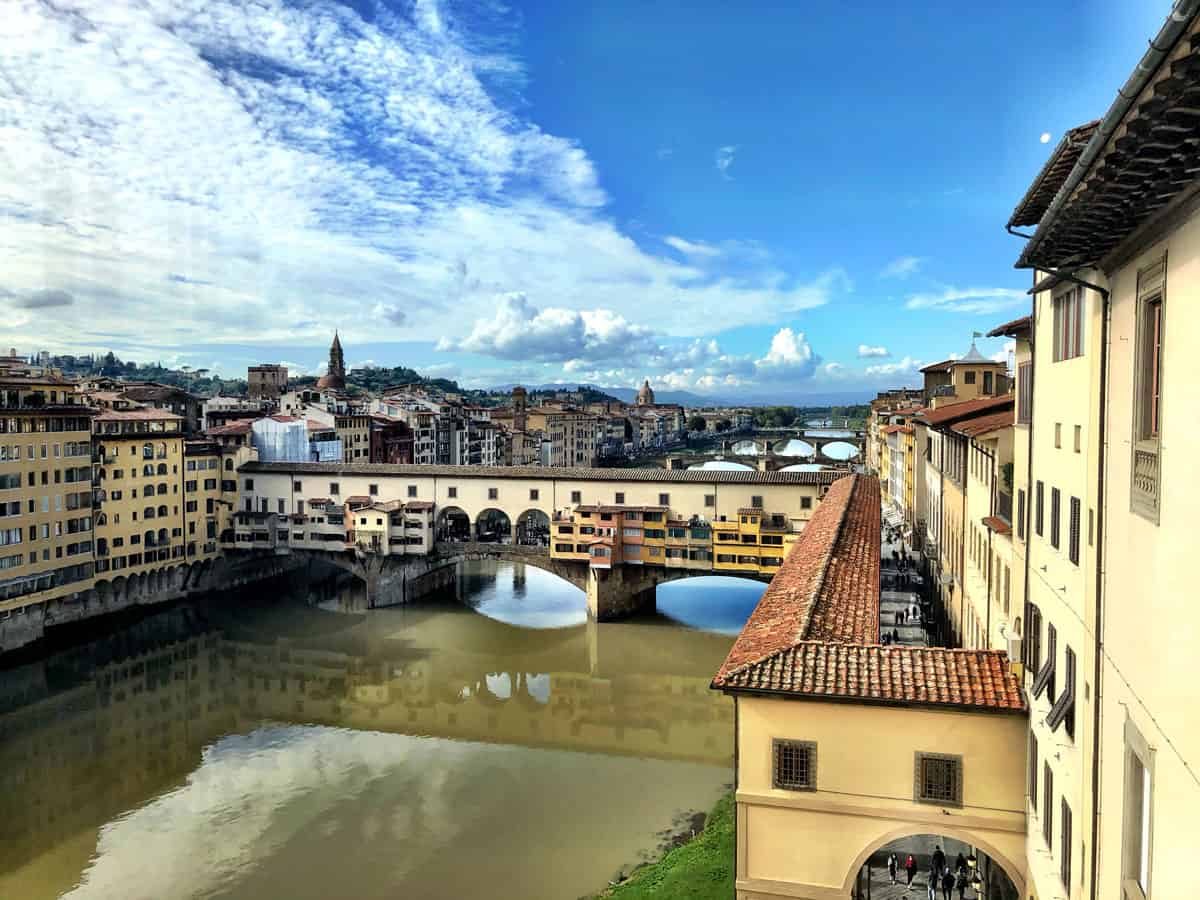
As you reach the bend in the U shape of the Uffizi, you won’t miss the wonderful view over the Arno river and the Ponte Vecchio bridge. Ponte Vecchio is the oldest bridge in Florence, dating all the way back to 1345. It used to be the sole bridge over the river, originally constructed by the ancient Romans. During World War II it was the only bridge left standing after a devastating Nazi bombing of the city that demolished the other bridges and the neighborhoods on either side of the Ponte Vecchio. It’s been through a lot to arrive at its current status of most famous bridge in Florence and dedicated almost exclusively to gold and jewelry shops. But there’s one more thing on the Ponte Vecchio that you can get an excellent view of from the Galleries,
Looking carefully from your vantage point in the Uffizi, notice the little square windows lining the top of the Ponte Vecchio? Those mark the famous Vasari Corridor, built by Giorgio Vasari for Cosimo I de Medici to serve as a approximately kilometer-long passageway from his residence at the Palazzo Vecchio through the Uffizi, over the bridge and all the way to Palazzo Pitti in the Oltrarno. A private highway, in effect. You can see where the corridor runs up the right side of the river and takes a right turn to come out at a door to your right.
Leonardo da Vinci Room
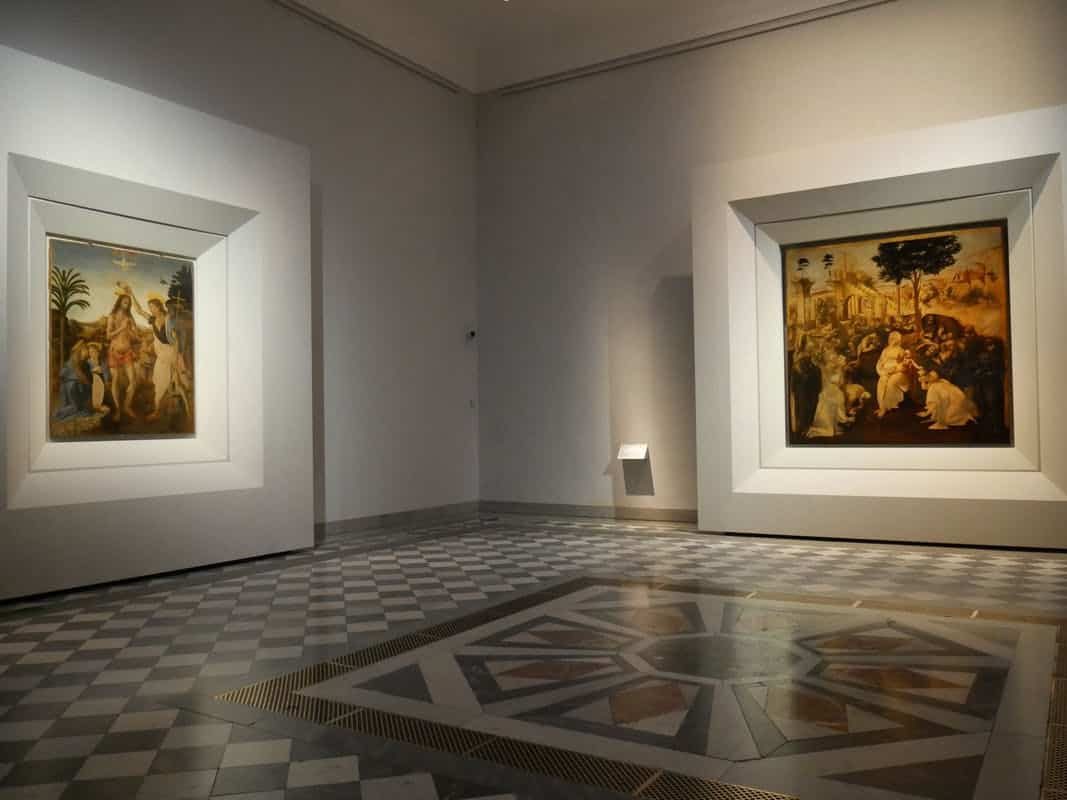
Leonardo da Vinci was many things: an artist, an inventor, a scientific observer of the natural world. In this room of the Uffizi you can see three of the masterpieces by the great genius that reveal the origins of the artist. The Baptism of Christ was the work of many hands in the workshop of Verrocchio where Leonardo was apprenticed and you can make out a few different styles in the painting. But it’s mostly agreed upon that Leonardo painted the angel in the bottom left with its head tilted up to Christ. Without a doubt the most delicate portrait in the painting, it’s said that when Verrocchio saw how much the student had surpassed the master, he broke his brush and never painted again. (Probably an exaggeration but a good story nonetheless.) The Annunciation was the first work we know of that Leonardo completed entirely on his own in his early 20s and The Adoration of the Magi is an unfinished work revealing his process of sketching and experimenting, shading various areas that would achieve the chiaro-scuro effect and puzzling over the expressions and emotions of his figures. His dedication to accurately representing the natural world is on display in all three paintings.
Michelangelo & Raphael Room
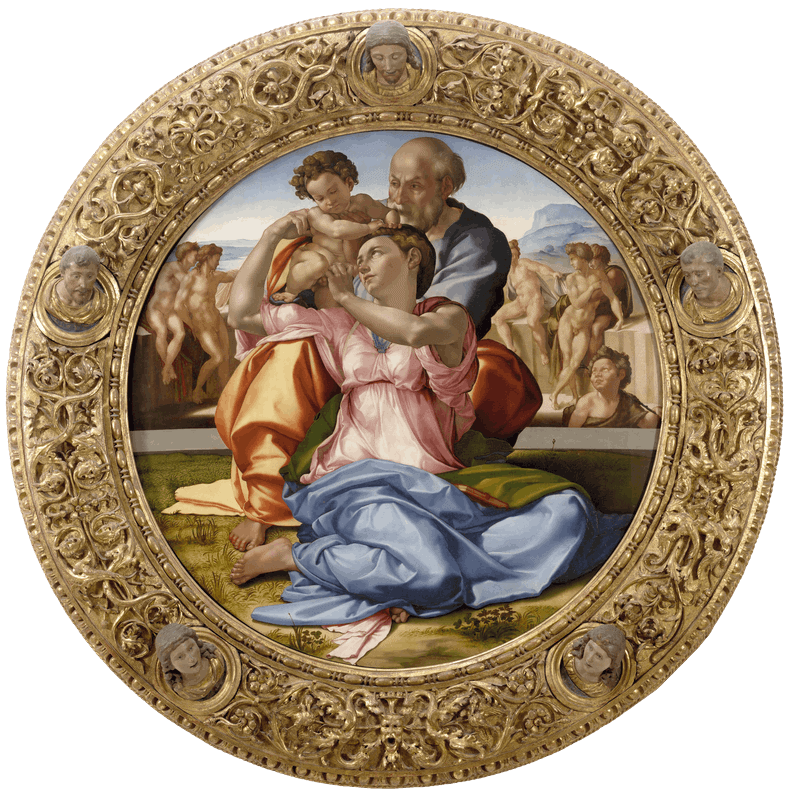
The painting of the Holy Family known as the Doni Tondo is Michelangelo’s only finished panel painting to survive to the present day and I love that it’s in company with so many Raphael paintings in the same room. While these two artists were notorious rivals (was there any artist Michelangelo wasn’t a rival with?) you can see why they would have had their differences in a single glance. The two masters had two distinctive styles.
Michelangelo’s figures in the Holy Family almost seem carved, weighty and vibrantly colored as if they represent an exalted super-human version of themselves. Raphael, in his portraits and his Madonnas, uses a softer line and gentle coloring that effuses harmony and grace. Don’t miss the portraits of Agnolo Doni and Maddalena Strozzi to the left of the Doni Tondo – it was their marriage for which they commissioned Raphael’s portraits and Michelangelo’s Doni Tondo.
The Niobe Room
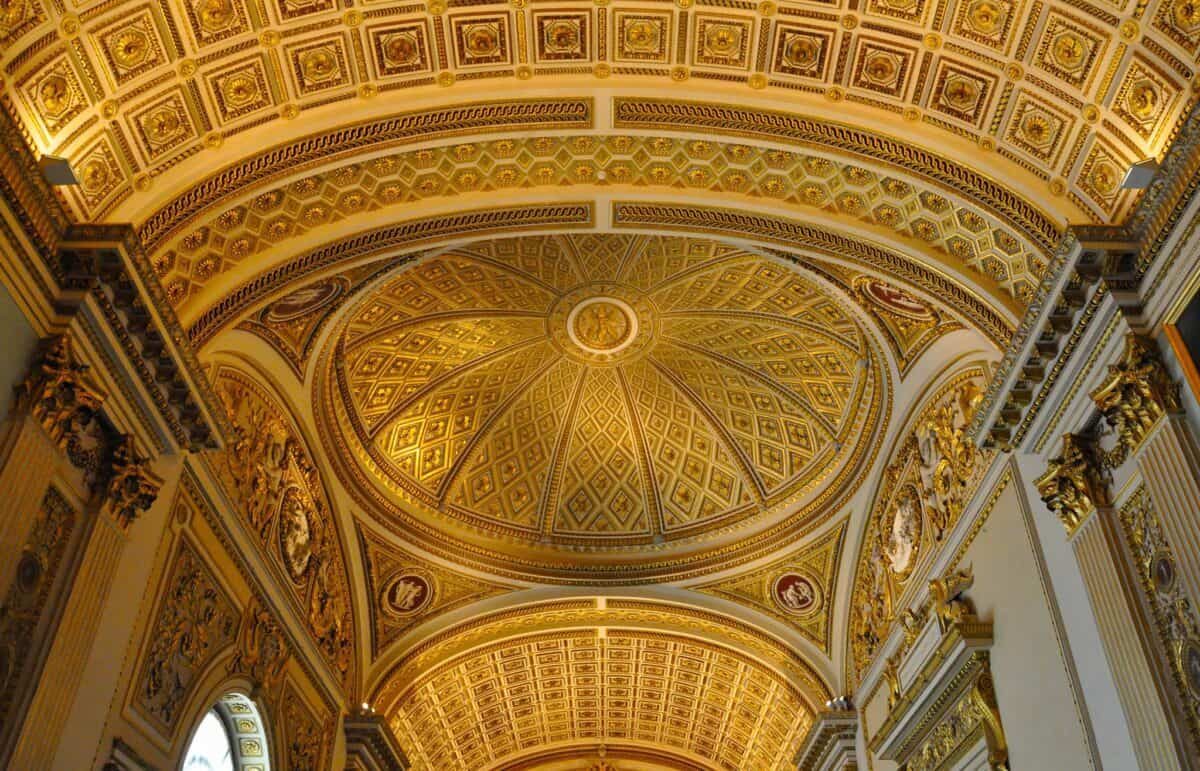
There’s one room that I always see people pass by, unaware of what they are missing. It’s toward the end of the final passage on top floor (the first that you visit) and by now you’ve been saturated in paintings and are getting more intrigued by the smell of coffee coming from the end of the hall then getting lost in another room of paintings. But don’t miss the beautiful Niobe room. Painted in moss green with an astounding gold leaf ceiling, it’s unlike any other room in the gallery as it was designed long after the Medici in 1780 under Pietro Leopoldo of the Habsburg-Lorraine dynasty (green interior decoration was kind of their “thing”). The room houses ancient roman statues of Niobe and her children (killed, in the Greek myth, because Niobe’s pride offended the mother of Artemis and Apollo). The end wall paintings are two gigantic paintings by Peter Paul Rubens: Henry IV at the Battle of Ivry and The Triumphal Entry of Henry IV into Paris. The pieces in juxtaposition with each other and complemented by the exquisite details of the room make this a must stop for me.
Loggia dei Lanzi view
Ok, now you can take a break in one of the most privileged positions in Florence: atop the Loggia dei Lanzi. You can grab a coffee and rest your feet in preparation for the next floor of the Uffizi gallery while taking in the view over the rooftops of Florence all the way to the dome of the cathedral. It’s also the best view of the Palazzo Vecchio’s decorative shields that you can get.
Titian’s Venus of Urbino
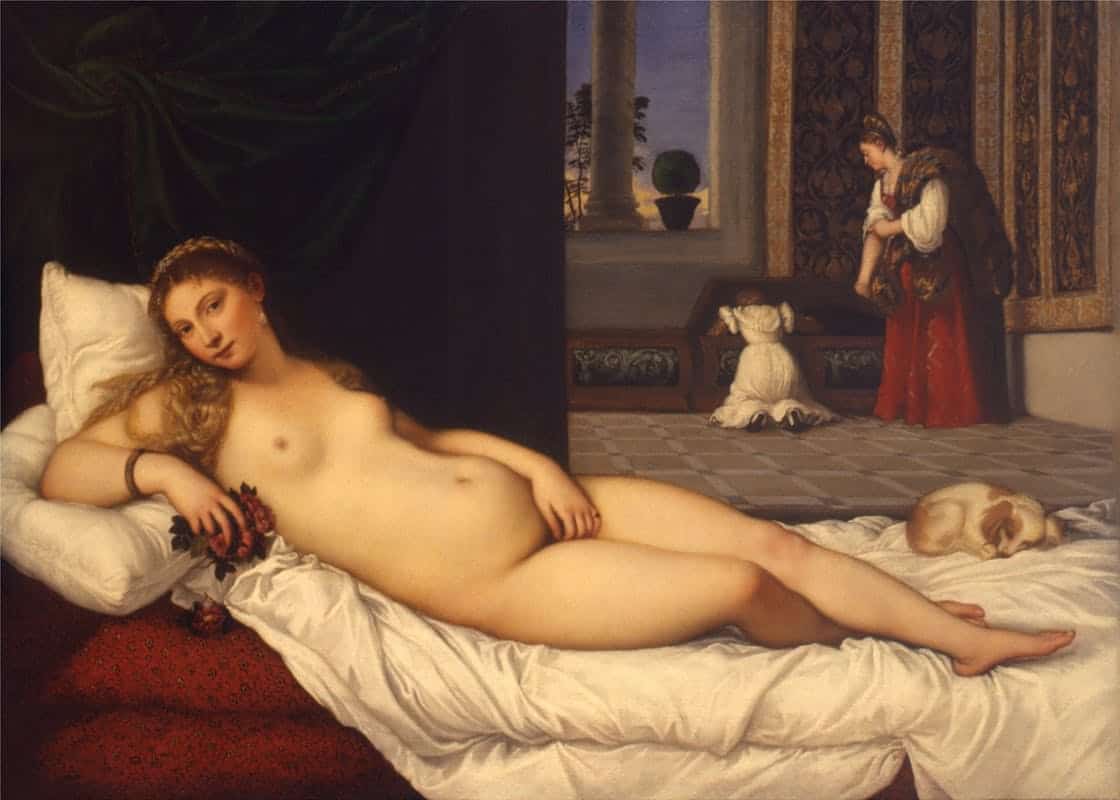
Entering the next floor of the Uffizi, you’ll find paintings by Bronzino, Pontormo, Rosso Fiorentino and Vasari but my favorite, tucked all the way in the back corner through what can start to feel like a bit of a labyrinth is Titian’s stunning Venus of Urbino (1538). Set against a forest green wall in the newly refurbished wing of the gallery, a soon to be bride is supposedly awaiting her servants to prepare for a betrothal ceremony. But don’t be fooled. This is Titian’s version of Venus incarnate. In this painting, the Greek and Roman goddess that inspired Botticelli has left the world of myth and entered into a contemporary Renaissance palazzo but she’s lost none of her sensuality and beauty.
Artemisia Gentileschi’s Judith Beheading Holofernes
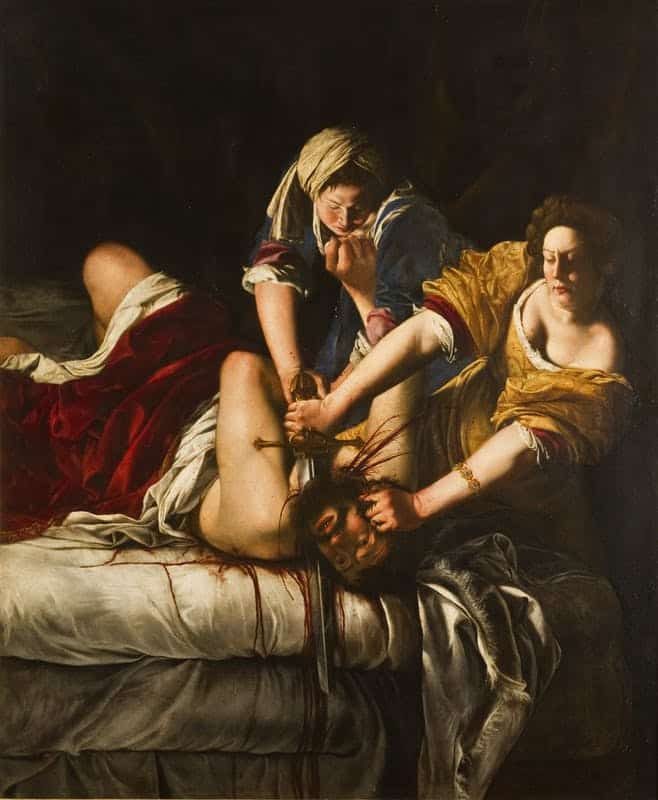
I know you’re tired by now but if you’re anything like me, this painting will hit you like a punch to the gut. The Biblical tale of Judith and Holofernes has been depicted hundreds of times in art: the Assyrian general Holofernes besieging the city of Bethulia is brought down by his own lust when Judith sneaks into his room, plies him with wine and flirtation and, once is guard is down, promptly relieves him of his head. But I challenge you to find a depiction of this story that is more visceral and real than this one. Judith is no shy lass but a hefty, muscular woman using all her strength to saw off the head of the general who has threatened her people. Many have drawn comparisons between Gentileschi’s depiction of this scene and her own desire for revenge after being raped by her painting tutor as a young woman. Whether or not feelings of revenge motivated the artist, Gentileschi’s Judith and Holofernes stands on its own as one of the most vital, determined, and formidable depictions of Judith in art history.
Caravaggio’s Head of Medusa
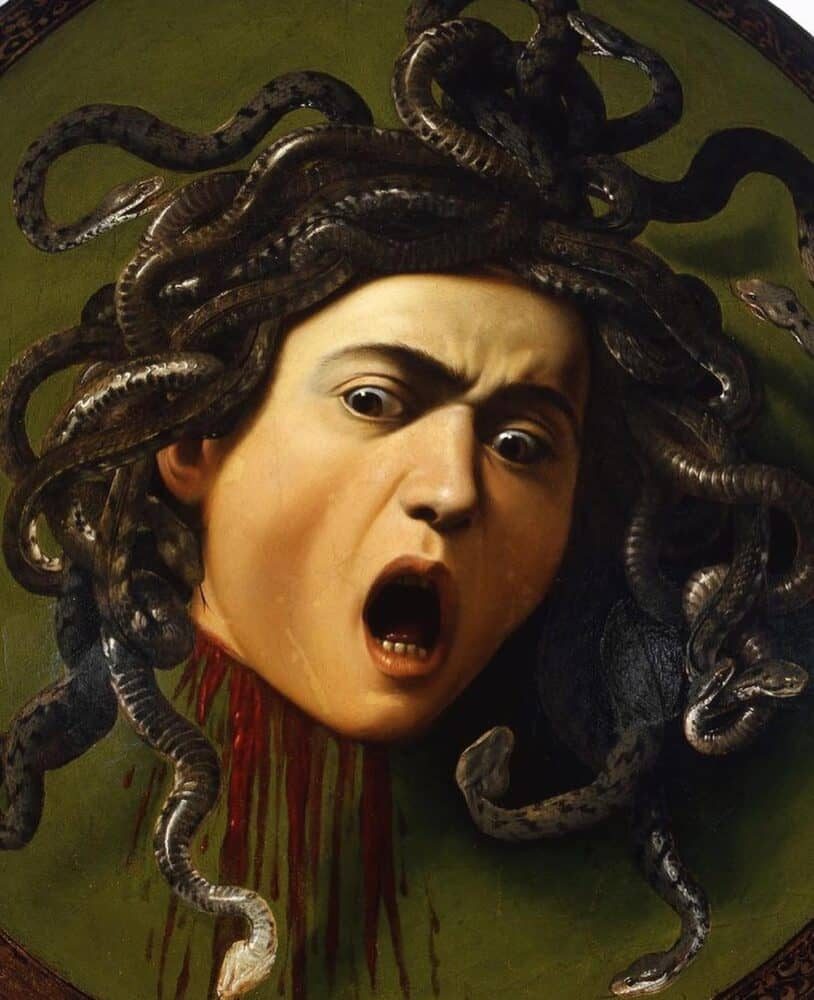
There’s simply no Medusa like Caravaggio’s Medusa. Partly because there’s no artist quite like Caravaggio when it comes to works oozing dramatic, dirty realism. Caravaggio took art to a new place that was exciting and shocking and asked his viewers to rethink all those pretty angels and damsels and heroes they had gotten used to during the Renaissance. And this is one piece where the medium actually tells part of the story, unlike any other in the gallery. Look closely, the painting is made on a shield. Remember, Medusa is the Greek mythological woman that was cursed to have snakes for hair and to turn all who looked at her to stone. Perseus defeats her by using the mirror on his shield to see where she is, so he can cut off her head without risking the eye contact that would turn him to stone. So, if Caravaggio paints her decapitation on a shield, he’s signaling not just a pivotal moment of the myth, but registering Medusa’s self-awareness as she witnesses her own demise. It doesn’t get more dramatic than that!
Uffizi Gallery Opening Hours
The Uffizi Gallery is open from Tuesday to Sunday, 8.15 am to 6.30pm. Closed on Mondays and 25 December.
Uffizi Gallery Tickets
Tickets Nov-Feb: €12 + €4 booking fee (reduced and children under 18 €2 + 4 booking fee)
Tickets March-Oct: €25 + €4 booking fee (reduced and children under 18 €2 + 4 booking fee)
Buy your tickets online in advance for a specific entry time so you can avoid a long line!


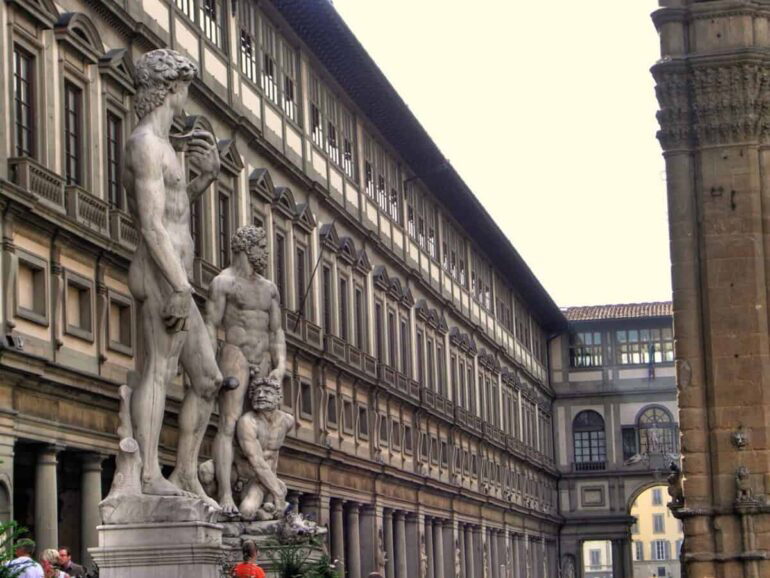







Thank you so much for this! We had only 2hrs to spend at the gallery today and not a clue where to start. Your list (in route order) with interesting information about the exhibits helped us to make the best of the short time we had there.
thank you Rose 🙂